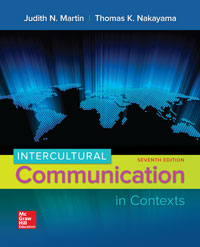Description
Test Bank For Intercultural Communication in Contexts Judith Martin 7 edition
CHAPTER 2
THE HISTORY OF THE STUDY OF INTERCULTURAL COMMUNICATION
MULTIPLE-CHOICE QUESTIONS
1. How did Edward T. Hall contribute to the origins of intercultural communication?
a. Hall developed a technology that increased our ability to communicate with people in other cultures.
b. Hall explored the relationship between a person’s national identity and values orientations.
c. Hall helped describe the relationship between language learning and conflict.
d. Hall identified and wrote about cultural differences in nonverbal communication.
Ans: d
2. Which of the following is true of the development of the intercultural communication area of study?
a. It originated with scholars looking for practical answers to help overseas workers.
b. This area of study is almost the same as the research done in the field of sociology.
c. It began as a result of people’s displeasure over the foreign relations concerning the Vietnam conflict.
d. The primary goal of scholars was to develop theories that described intercultural communication processes.
Ans: a
3. Researchers who use the _____ approach to studying intercultural communication are interested not only in understanding human behavior but also in changing the lives of everyday communicators.
a. rhetorical
b. interpretive
c. critical
d. functionalist
Ans: c
4. Which of the following approaches to studying intercultural communication assumes that human behavior is predictable and that culture is a variable that can be measured?
a. the functionalist approach
b. the interpretive approach
c. the critical approach
d. None of the answers is correct.
Ans: a
5. Which of the following is primarily used in the critical approach to studying intercultural communication?
a. field studies and observations
b. questionnaires and observations
c. textual analysis of media
d. interviews and experiments
Ans: c
6. The social science approach to studying intercultural communication is also called the:
a. variable approach.
b. qualitative approach.
c. functionalist approach.
d. collectivist approach.
Ans: c
7. Researchers using a critical perspective attempt to explain:
a. how macrocontexts such as political structures influence communication.
b. how specific cultural differences might predict communication conflicts.
c. intercultural communication by providing in-depth descriptions of cultural patterns.
d. variations in communication strategies used by people from different cultures.
Ans: a
8. One limitation of the social science approach to studying intercultural communication is:
a. the potential to place too much focus on the historical and political contexts while ignoring the relationships between the people being studied.
b. the lack of empirical measures for assessing communication strategies.
c. the possibility that the methods used in this approach are not culturally sensitive.
d. the inability to compare communication interactions between different cultural groups.
Ans: c
9. The goal of the _____ approach to studying intercultural communication is to predict specifically how culture influences communication.
a. critical
b. interpretive
c. rhetorical
d. social science
Ans: d
10. The study of how people use personal space is called:
a. pathetic.
b. psychology.
c. linguistics.
d. proxemics.
Ans: d
11. Which dialectic of intercultural communication addresses the fact that some of our cultural patterns are constant and some are shifting?
a. history/past–present/future dialectic
b. differences–similarities dialectic
c. static–dynamic dialectic
d. privilege–disadvantage dialectic
Ans: c
12. Which of the following might explain why early intercultural researchers paid little attention to intercultural communication in domestic contexts?
a. Most of the researchers had international intercultural experience.
b. They were disinterested in studying conflicts.
c. Most felt that this research would involve a violation of personal ethics.
d. There were no research instruments designed for use in domestic studies.
Ans: a
13. The privilege–disadvantage dialectic recognizes that:
a. all people are disadvantaged in most contexts.
b. all people are advantaged if they decide to be.
c. some people are disadvantaged in some contexts and neutral in others.
d. some people are disadvantaged in some contexts and privileged in other contexts.
Ans: d
14. _____ are underlying assumptions about the nature of reality and human behavior.
a. Proxemics
b. Dialectics
c. Worldviews
d. Macrocontexts
Ans: c
15. Gudykunst’s studies based on individualistic versus collectivist values that explain how communication styles vary from culture to culture are an example of:
a. critical research.
b. rhetorical research.
c. interpretive research.
d. social science research.
Ans: d
16. Which of the following is an example of emic research?
a. researching the communication strategies people in India use to show respect
b. researching the differences in the management styles of Japanese and German managers
c. researching how emotions are understood cross-culturally
d. researching similarities in the child-rearing styles of Samoan and Tongan mothers
Ans: a
17. Which of the following is true of Asante’s notion of Afrocentricity?
a. All scholarly studies in communication should be based on African instead of European research perspectives.
b. People of African descent value nature over human beings.
c. People of African descent value communalism.
d. Descriptions of the communication rules of given people must be grounded in the beliefs and values of that particular group.
Ans: c
18. Researchers who assume that their research can help people resist forces of power and oppression represent the _____ approach to studying intercultural communication.
a. social science
b. interpretive approach
c. functionalist approach
d. critical approach
Ans: d
19. An intellectual, political, and cultural movement calling for the independence of colonized states is:
a. accommodation.
b. postcolonialism.
c. paradigm.
d. processual.
Ans: b
20. If we attempted to study intercultural communication without considering the perspective of the critical approach, we would miss:
a. understanding how specific cultural differences might predict communication outcomes.
b. the role of history in our present intercultural interactions.
c. the knowledge about specific behaviors in a culture that should be used to show respect.
d. an understanding of how the cultural patterns of a specific culture reflect cultural values.
Ans: b





Be the first to review “Test Bank For Intercultural Communication in Contexts Judith Martin 7 edition”